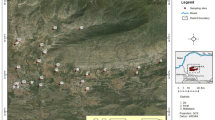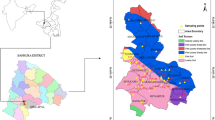Abstract
The water samples from the shallow aquifers of Makur, Unnao district, Uttar Pradesh, was analyzed for fluoride content (F − ) and other water quality parameters such as pH, EC, CO3 2−, HCO3 −, Cl − , Na + , Ca2 + , Mg2 + and RSC. It was found that the F − concentration of water varied between 1.05 to 13.9 mgl − 1 which exceeded the maximum desirable limits of 1.0 mgl − 1 of F − as laid down by BIS and 68% of water exceeded maximum permissible limits of 1.5 mgl − 1 as prescribed by WHO. The correlation study of fluoride indicated that F − has a significant (p < 0.05) positive relationship with pH (r = +0.59) and RSC (r = 0.54), while a significant negative correlation with Ca+Mg (r = −0.53) and Mg (r = −0.49). The exposure doses of fluoride in infants was found between 0.35 to 3.26 mg kg − 1day − 1 (if dug well water was used) whereas 0.36 to 4.63 mg kg − 1day − 1 (when shallow hand pumps) The exposure doses of water in case of children (20 kg body weight) varied between 0.157 to 1.47 mg kg − 1day − 1 (for dugwell) and 0.162 to 2.08 mg kg − 1day − 1 (for shallow hand pumps) whereas in case of adults (70 kg body weight), it varied between 0.09 to 0.839 mg kg − 1day − 1 (for dugwell) and 0.092 to 1.19 mg kg − 1day − 1 (shallow hand pumps) which is quite high against the standard value of 0.05 mg/kg/day which is the minimum risk level (MRL) calculated by the Agency for Toxic Substances and Disease Registry (ATSDR). The maximum exposure dose to fluoride for adults in the study area found to be 23.8 times higher than the ATSDR’s MRL.
Similar content being viewed by others
References
Agarwal, C. S., & Choudhary, N. K. (2001). Fluoride pollution in ground water and related ill effects with geomorphological mapping using IRS data in parts of Unnao district. U.P. BSI Spl. Pub. No., 65(II), 187–189.
Grimaldo, M., Borja, V., Ramirez, A. L., Poncce, M., Rosas, M., & Diaz-Barriga, F. (1995). Endemic fluorosis in San Luis Potosi, Mexico. I. Identification of risk factor associated with human exposure to fluoride. Environmental Research, 68, 25–30. doi:10.1006/enrs.1995.1004.
Gupta, S., Banerjee, S., Saha, R., Datta, J. K., & Mondal, N. (2006). Fluoride geochemistry of ground water in Nalhati-1 bolck of Birbhum district, West Bengal. Fluoride, 39(4), 318–320.
Gupta, S. C., Doshi, C. S., & Paliwal, B. L. (1986). Occurrence and chemistry of high fluoride ground waters in Jalore district of Western Rajasthan. Annal of Arid Zone, 25, 255–264.
Gupta, M. K., Singh, V., Rajwanshi, P., Srivastava, S., & Dass, S. (1994). Ground water fluoride level in rural area of district Agra. Indian Journal of Environmental Protection, 14(5), 370–372.
GSI (2001). District Resource Map, Unnao, Uttar Pradesh. Geological Survey of India, Northen Region
Handa, B. K. (1975). Geochemistry and genesis of fluoride containing ground waters in India. Ground Water, 13(3), 275–281. doi:10.1111/j.1745-6584.1975.tb03086.x.
Kumar, S., Rai, D., Rai, P. K., Shukla, A. B., & Saxena, A. (2004). Fluoride pollution in ground water in parts of Unnao district: Impact and distribution. Extended summaries. In International conference on sustainable management of sodic land (p. 474).
Lenore, S. C., Arnold, E. G., & Andrew, D. E. (Eds.). (1998). Standard methods for the examination of water and waste water (20th ed.). Washington DC: American Public Health Association.
Muralidharan, D., Nair, A. P., & Satyanarayana, U. (2002). Fluoride in shallow aquifers of Rajgarh, tehsil of Churu district, Rajasthan—an arid environment. Current Science, 83(6), 699–702.
Nawlakhe, W. G., & Bulusu, K. R. (1989). Water treatment technologies for removal of excessive fluoride. In C. P. Gupta (Ed.), Appropriate methodologies for development and management of ground water resources in developing countries (Vol. 2, pp. 815–828). New Delhi: Oxford and IBH Publishers Ltd.
Ortiz, D., Castro, L., Turrubiartes, F., Milan, J., & Diaz-Barriga, F. (1998). Assessment of the exposure to fluoride from drinking water in Durango, Mexico, using a geographic information system. Fluoride, 31(4), 183–187.
Singh, B., & Narayan, P. (1980). Relationship between fluoride and other characteristics of underground irrigation waters in brackish water belt. Agrochimica, 24(203), 207–211.
Tiwari, A. K., Dikshit, R. P., Tripathi, I. P., & Chaturvedi, S. K. (2003). Fluoride content in drinking water and ground water quality in rural areas of Tehsil Mau district, Chitrakoot. Indian Journal of Environmental Protection, 23(9), 1045–1050.
World Health Organisation (1993). Guidelines for drinking water quality recommendations (2nd ed.). Geneva: World Health Organisation.
Author information
Authors and Affiliations
Corresponding author
Rights and permissions
About this article
Cite this article
Jha, S.K., Nayak, A.K. & Sharma, Y.K. Fluoride occurrence and assessment of exposure dose of fluoride in shallow aquifers of Makur, Unnao district Uttar Pradesh, India. Environ Monit Assess 156, 561–566 (2009). https://doi.org/10.1007/s10661-008-0505-1
Received:
Accepted:
Published:
Issue Date:
DOI: https://doi.org/10.1007/s10661-008-0505-1




